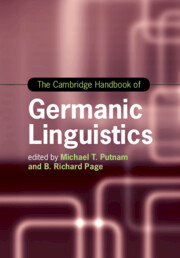Book contents
- The Cambridge Handbook of Germanic Linguistics
- Cambridge Handbooks in Language and Linguistics
- The Cambridge Handbook of Germanic Linguistics
- Copyright page
- Contents
- Figures
- Maps
- Tables
- Contributors
- Acknowledgments
- Germanic Languages
- Part I Phonology
- Part II Morphology and Agreement Systems
- Part III Syntax
- Part IV Semantics and Pragmatics
- Part V Language Contact and Nonstandard Varieties
- Chapter 29 Second Language Acquisition of Germanic Languages
- Chapter 30 Urban Speech Styles of Germanic Languages
- Chapter 31 The West Germanic Dialect Continuum
- Chapter 32 The North Germanic Dialect Continuum
- Chapter 33 Heritage Germanic Languages in North America
- Chapter 34 Minority Germanic Languages
- Chapter 35 Germanic Contact Languages
- Index
- References
Chapter 30 - Urban Speech Styles of Germanic Languages
from Part V - Language Contact and Nonstandard Varieties
Published online by Cambridge University Press: 31 March 2020
- The Cambridge Handbook of Germanic Linguistics
- Cambridge Handbooks in Language and Linguistics
- The Cambridge Handbook of Germanic Linguistics
- Copyright page
- Contents
- Figures
- Maps
- Tables
- Contributors
- Acknowledgments
- Germanic Languages
- Part I Phonology
- Part II Morphology and Agreement Systems
- Part III Syntax
- Part IV Semantics and Pragmatics
- Part V Language Contact and Nonstandard Varieties
- Chapter 29 Second Language Acquisition of Germanic Languages
- Chapter 30 Urban Speech Styles of Germanic Languages
- Chapter 31 The West Germanic Dialect Continuum
- Chapter 32 The North Germanic Dialect Continuum
- Chapter 33 Heritage Germanic Languages in North America
- Chapter 34 Minority Germanic Languages
- Chapter 35 Germanic Contact Languages
- Index
- References
Summary
This chapter gives an overview of contemporary urban speech styles in Northern European cities as they have been described by sociolinguists throughout Scandinavian and Northern European countries. By “contemporary urban speech styles” we refer to new contact-induced speech styles or varieties that have emerged among young people in multilingual urban neighborhoods. The chapter outlines linguistic parallels that have been documented across Scandinavia in particular, as well as in Northern Europe, focusing on, first, structural findings such as variation of the verb second constraint, variation of grammatical gender, variation in pronunciation as well as lexical features; second, the chapter gives an account of studies on social identities connected to, perceptions of and media constructions of contemporary urban speech styles.
- Type
- Chapter
- Information
- The Cambridge Handbook of Germanic Linguistics , pp. 714 - 735Publisher: Cambridge University PressPrint publication year: 2020

